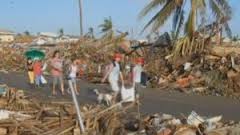 In the aftermath of Super Typhoon Haiyan last year, Roge Agujero’s family went back to the plot of land near the sea where their house once stood.
In the aftermath of Super Typhoon Haiyan last year, Roge Agujero’s family went back to the plot of land near the sea where their house once stood.
“We did not see anything, not even a single post,” he said.
The ferocious storm had obliterated the building where more than a dozen of Agujero’s family members lived, one of thousands of homes destroyed in the area around the Philippine city of Tacloban. Entire neighborhoods were smashed into tangled heaps of debris. More than 6,000 people were killed.
Agujero’s family has spent much of the past year rebuilding their house, taking pains to make it sturdier than its wooden predecessor by using concrete.
The work isn’t finished, but a new threat is already on the horizon.
Another powerful storm, Super Typhoon Hagupit, is approaching the Philippines from the same part of the western Pacific Ocean as Haiyan did 13 months ago.
For residents of Tacloban and the surrounding region, the parallels are deeply unsettling.
“I’m more than nervous because I have experienced what Yolanda brought,” 23-year-old Agujero said, using the Filipino name for Haiyan. “I don’t know what will happen next after another super typhoon.”
It’s not yet clear exactly what path Hagupit will take. Some forecasts have it on a similar path to Haiyan, crashing into the region around Tacloban over the weekend. Others suggest it may turn sharply to the right before it reaches land and then move north, up the eastern seaboard of the Philippines.
Many local residents around Tacloban aren’t taking any chances.
Long lines were reported Thursday at supermarkets, ATMs and gas stations as people stocked up on supplies. The local government and relief organizations have begun putting emergency preparation plans into action.
“Unlike last year, there are a lot of UN agencies and INGO partners on the ground in Tacloban and other cities … ready to provide support and assistance,” said Maulid Warfa, chief of UNICEF’s office in Tacloban, referring to international non-governmental organizations.
Local people are also appear to be more attuned to the potential risks.
As Haiyan bore down on Tacloban last year, a lot of residents didn’t hear or heed government warnings to relocate from coastal areas. Some of them pointed to the blazing sun in the sky the day before the storm hit as proof that there was no need to be concerned, Agujero said.
Haiyan’s massive storm surge caught many of them in their homes as it roared in off the Gulf of Leyte, splintering buildings and tossing large ships onto dry land.
CNN
 Q FM Africa's Modern Radio
Q FM Africa's Modern Radio